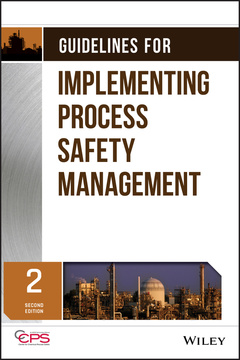Description
Guidelines for Implementing Process Safety Management (2nd Ed.)
Author: CCPS (Center for Chemical Process Safety)
Language: English
Subjects for Guidelines for Implementing Process Safety Management:
128.91 €
In Print (Delivery period: 14 days).
Add to cart352 p. · 16x23.6 cm · Hardback
Description
/li>Contents
/li>Biography
/li>
The 2nd edition provides an update of information since the publication of the first edition including best practices for managing process safety developed by industry as well as incorporate the additional process safety elements. In addition the book includes a focus on maintaining and improving a Process Safety Management (PSM) System. This 2nd edition also provides "how to information to" determine process safety performance status, implement one or more new elements into an existing PSM system, maintain or improve an existing PSM system, and manage future process safety performance.
Files on the Web Accompanying this Book xi
List of Figures xiii
List of Tables xv
Acronyms and Abbreviations xvii
Glossary xxi
Acknowledgments xlix
Preface li
1 INTRODUCTION 1
1.1 Overview 1
1.2 Background/History of PSM 5
1.3 Process Safety Resources 7
1.4 PSM Implementation Lessons 11
1.5 The Business Case for Process Safety 12
1.6 Importance of Integrating PSM with Business Systems 14
1.7 Intended Audience and How to Use These Guidelines 16
1.8 References 18
2 EVALUATING PSM SYSTEM IMPLEMENTATION AND PERFORMANCE 19
2.1 The Modified Safety Triangle 19
2.2 Common Indicators at Each Level of the Triangle 21
2.3 Process Stages in the Company/Facility Life Cycle 22
2.4 Documenting Conclusions 31
2.5 References 35
3 PREPARING FOR PROCESS SAFETY MANAGEMENT CHANGE 37
3.1 Securing Management Commitment 37
3.2 Establishing a Culture for Change 44
3.3 References 48
4 IMPLEMENTING A NEW PSM SYSTEM 49
4.1 Develop the Design Specification for the PSM System 49
4.2. Create Element and System Workflows 67
4.3 Estimate the Workloads and Resources 76
4.4 Develop Written Programs/Procedures 87
4.5 Roll Out the Elements and System 98
4.6 Monitor the PSM System's Implementation, Initial Performance, and Progress 113
4.7 References 115
5 INTEGRATING NEW ELEMENTS INTO AN EXISTING PSM SYSTEM 117
5.1 Developing a New Element 117
5.2 Integrating New Element Activities into Existing Elements 118
5.3 Implementing New RBPS Elements 118
5.4 Monitoring New Elements or Activities 133
5.5 References 134
6 IMPROVING AN EXISTING PSM ELEMENT OR SYSTEM 137
6.1 Determining Which Elements to Improve 137
6.2 Assessing the Program and Determining the Root Causes of Poor Performance 142
6.3 Improving the PSM Program 159
6.4 Developing the Solution for an Element or System 162
6.5 Monitoring Improvement of an Element or System 163
6.6 References 166
7 INTEGRATING PSM/HSE WITH A BUSINESS MANAGEMENT SYSTEM 167
7.1 Values and Policy Interfaces/Conflicts with Business Enterprise 168
7.2 Types of BMS Activities 168
7.3 Company and Regional Politics 179
7.4 Workflows/Processes of Existing BMS 179
7.5 Planned Changes to Existing BMS 179
7.6 Interfaces with Existing BMS 179
7.7 Resolving BMS Conflicts 179
7.8 References 180
8 MANAGING FUTURE PROCESS SAFETY PERFORMANCE 181
8.1 Ensure a Robust PSM System 181
8.2 Avoid Past PSM System Failure Modes 183
8.3 Watch for Early Warning Signs 186
8.4 Consider Other Enhancements 188
8.5 References 189
APPENDIX I: GLOBAL PSM REGULATIONS/GOOD INDUSTRY PRACTICES 191
APPENDIX II: ELI LILLY AND COMPANY PSM IMPLEMENTATION CASE STUDY 223
APPENDIX III: RISK BASED PROCESS SAFETY (RBPS)IMPLEMENTATION TOOLS 241
APPENDIX IV: THE BUSINESS CASE FOR PROCESS SAFETY 251
APPENDIX V: EXAMPLE FACILITY RANKING PROCESS 267
APPENDIX VI: EXAMPLE PRESENTATION ON PSM PLAN 271
APPENDIX VII: MAPPING PERFORMANCE ISSUES TO CULTURE FEATURES 275
INDEX 283
Since 1985, the Center for Chemical Process Safety (CCPS) has been the global leader in developing and disseminating information on process safety management and technology. CCPS, an industry technology alliance of the American Institute of Chemical Engineers (AIChE), has published over 100 books in its process safety guidelines and process safety concepts series, and over 100 training modules through its Safety in Chemical Engineering Education (SACHE) series.

